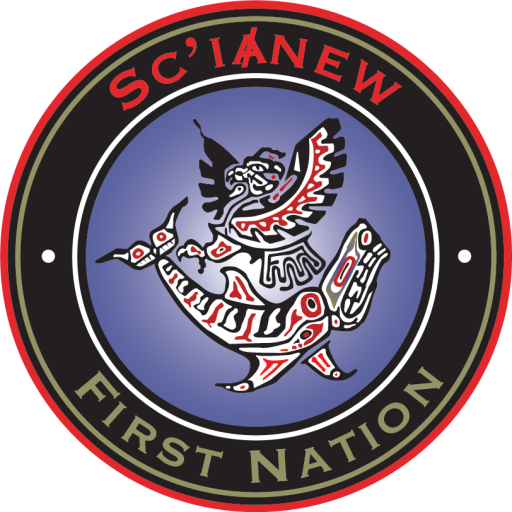Our History & Accomplishments
Discover the history and achievements of SC’IȺNEW First Nation.
Introduction
SC’IȺNEW Nation consistently builds upon the work of past SC’IȺNEW leaders and Elders to create a healthy community with abundant opportunity for all.
Explore SC’IȺNEW Nation’s history, initiatives to foster financial well-being in the community, land stewardship efforts, and treaty development work below.

1. Our History
SC’IȺNEW Nation, also known as Beecher Bay First Nation, is a band government currently located on a 307.70 hectare reserve on southern Vancouver Island. The current Chief of SC’IȺNEW Nation is Chief Russ Chipps, and Council members include Traci Pateman and Sheeba Sawyer.
Though not all are currently spoken, the Halq’eméylem, hən̓q̓əmin̓əm̓, Hul’q’umi’num’, Lkwungen, Malchosen, Nəxʷsƛ̕ay̓əmúcən (Klallam), Semiahmoo, SENĆOŦEN, and T’Sou-ke languages are all recognized. The primary language is SENĆOŦEN.
XEMXIMELEḴ (Burt Charles) is one of the many important leaders of SC’IȺNEW Nation. As an Elder, Hereditary Chief, former Council Member, elected Chief for two decades, and current cultural educator, XEMXIMELEḴ has spent over 60 years leading the community.
During his time as elected Chief, XEMXIMELEḴ greatly improved the quality of life for the community. He brought electricity and running water to SC’IȺNEW Nation, restored the community’s traditional fishing rights, contributed to the founding of the Union of British Columbia Indian Chiefs in 1969, worked to secure critical infrastructure such as new homes and paved roads, protested Prime Minister Pierre Trudeau’s White Paper, and wrote his own “Brown Paper,” which became foundational in the movement towards reconciliation.
His radical action extended to his own home, where he and his wife SPOȽTENOT (Lavina Charles) fought educational segregation by having their own daughter be the first child of SC’IȺNEW Nation to attend public school.
To learn more, visit the Royal Roads University website.
2. Building a Healthy, Sustainable Community
To learn more, read the article in the Times Colonist.
To learn more, read the article in the Vancouver Island Free Daily.
To learn more, read the article in the Times Colonist.
The cultural centre will create a central hub in the already-bustling town of Spirit Bay, which features an oil-spill response centre, a fishing marina, and many more amenities.
To learn more, read the article in the Times Colonist.
The route – which provides service on weekdays – will bring new opportunities to community members, making it easier to build successful, abundant lives.
To learn more read the Chek News article.
The swap included the transfer of 250 acres of treaty lands from SC’IȺNEW Nation to Metchosin in exchange for a stake in a new business park development. All 350 acres of land used for the business park were placed within Langford to allow access to necessary infrastructure, creating a mutually-beneficial partnership between SC’IȺNEW Nation, Metchosin, and Langford.
This agreement and the resulting revenue for SC’IȺNEW Nation creates greater opportunities for the community.
To learn more, read the article in the Times Colonist.
3. Land Stewardship, and Recognition
If the Tribal Park is established, SC’IȺNEW Nation will be the primary protectors and stewards of the land, an important transition given the land is home to several at-risk species, is part of a rare ecosystem, and is a core part of the SC’IȺNEW Nation’s traditional territory.
Treaty negotiations are underway to transfer Mary Hill from the Department of National Defence to SC’IȺNEW Nation via SC’IȺNEW Nation’s work with the Te’mexw Treaty Association.
To learn more, read the article in Indiginews and visit the official SC’IȺNEW Tribal Park website.
The vessels combine a traditional understanding of stewardship with new technologies to ensure the SC’IȺNEW Nation is at the forefront of protecting the animals and ecosystems of the Salish Sea, all while creating jobs and skill-developing opportunities for the community.
To learn more, read the article in Coast Reporter.
Pearson College is located on the traditional territory of SC’IȺNEW Nation, and the new names and artwork provide important recognition of that fact. They are also a reflection of the college’s commitment to ground education in Indigenous knowledge and environmental stewardship.
Chief Russ Chipps and Elders Rick Peter and Henry Chipps joined the college’s students and staff to celebrate the renaming on November 18, 2021.
To learn more, read the article on Island Social Trends.
The naming of SĆIȺNEW̱ SṮEȽIṮḴEȽ – which is located on the traditional territory of SC’IȺNEW Nation – is an important act of reconciliation, particularly considering the historical forced erasure of Coast Salish language and culture from schools.
To learn more, read the Times Colonist article.
4. Reclaiming Our Rights
As part of the Association, SC’IȺNEW Nation is working to create its own just and fair Treaty and Constitution that address the topics missed in the Douglas Treaties. The ultimate goal is to reach an agreement with the federal and provincial governments that results in land ownership and self-governance. The Treaty is expected to include the transfer of Mary Hill to SC’IȺNEW Nation.
To learn more, visit the Te’mexw Treaty Association website.
